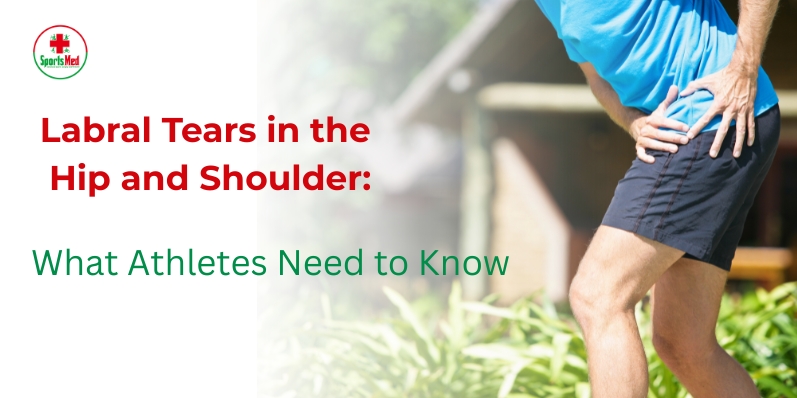
Labral Tears in the Hip and Shoulder: What Athletes Need to Know
Athletes involved in tennis, baseball, football, and hockey are prone to labral tears. Such injuries can affect both the hip and shoulder joints and may remain undiagnosed until the pain becomes intolerable. Labral tearing affects sports activity in the short- and long-term, left untreated, it may also worsen joint-related issues. This blog discusses the labrum, its various types of labral tears, preventive measures for athletes, and treatment options.
What Is the Labrum? Know in Detail About Its Functions
The labrum is a cartilage ring found in both the shoulder and hip joints. It stabilizes the joint, allowing for smooth and controlled movements.
Functions of the Labrum
● Joint Stability: It deepens the socket to receive the ball of the joint better. ● Shock Absorption: C Cushioning high-impact movements
● Lubrication: Helps in the movement of synovia, a fluid that keeps friction at bay. ● Attachment Site: Serves as an anchor point for ligaments and tendons.
The labrum will be subjected to a range of forces and stresses in rapid and dynamic motions by athletes, potentially leading to wear, tear, or injury.
What Is a Labral Tear and Its Types?
A labral tear is a tear in the cartilage and a separation of it from the bone, through trauma, overuse, or structural abnormality. Labral tears commonly develop in the shoulder and hip joints, resulting in distinct symptoms that vary depending on the location and underlying cause.
1. Shoulder Labral Tears
● Common in overhead athletes, such as throwers and swimmers.
● Anterior shoulder pain, sensation of catching, or locking.
● Bankart Tear
● Usually occurs along with dislocation.
● It involves the lower part of the labrum and causes a feeling of instability in the shoulder.
● Posterior Labral Tear
● Rare, typically found in weightlifters or athletes who apply repetitive backward motions.
2. Hip Labral Tears
Usually brought about by repetitive twisting motions or sudden changes in direction, trauma might enter into the equation (falls or collisions). According to studies, nearly 55% of athletes with groin pain have labral tears, and about 25% of shoulder dislocations involve damage to the labrum.
How to Prevent Labral Tears in Athletes?
The following are a few tips for reducing the risk, though not all labral tears can be prevented, especially in contact sports:
1. Muscular Strengthening Around the Joint
● Strengthen the muscles of the shoulder and hips to reduce stress on the labrum. ● Work on core stability and posture, especially in rotational sports.
2. Warm-Up and Mobility Work
● Perform dynamic warm-up exercises before training.
● Stretch muscles around the shoulder and hip to increase flexibility.
3. Correct Technique
● Poor throwing or batting techniques can increase the load on joints. ● Seek coaching or sports physiotherapy to enhance biomechanics.
4. Avoid Overtraining
● Ensure sufficient rest is given between sessions.
● Use proper equipment, particularly shoes that absorb shock, to reduce the impact on your hips.
5. Early Intervention
● Symptoms of clicking, catching, or joint instability should not be ignored. ● The earlier it gets treated, the more the rehab can prevent surgery. According to experts at Sports Injury Care, regular functional movement screening can detect joint abnormalities in their early stages in athletes.
Treatment Options for Labral Tears
It depends on how much the tear extends or its location. Sometimes, early treatment can prevent the need for surgical intervention.
1. Conservative Treatment
● Rest and Activity Modification: Avoid movements that aggravate the symptoms.
● Physical Therapy: Strengthen muscles around the joint and bilaterally correct joint misalignment, if any is present.
● Anti-inflammatory Medication: To decrease swelling and to relieve pain.
2. Injections
● Corticosteroid injections may be used to relieve symptoms, although the relief is temporary.
● PRP (Platelet-Rich Plasma): To accelerate the healing process, particularly in the case of partial tears.
3. Surgery
If the nonoperative treatment fails and the tear is large:
Arthroscopic Surgery: A minimally invasive method to repair or remove torn parts. Recovery includes:
● 4-6 weeks of rest
● 3-6 months of rehabilitation
● Gradual return to sports
4. Post-Treatment Rehabilitation
Rehabilitation remains essential, irrespective of surgical procedures. A well-guided rehab program may involve:
● Strengthening
● Mobility work
● Sport-specific drills
● Injury prevention education
At Sports Injury Care, our rehab programs are tailored to athletes based on their specific sport and injury history.
Conclusion
Labral tears in the hip or shoulder can be career-enders for any athlete, particularly those considered specialized. However, with sufficient knowledge about the injury, one can treat it or, even better, prevent it. Above, leaving the body at the mercy of whatever might come, or having nagging joint pain, it is essential to note any warning signals the body sends and to follow a preemptive training and recovery schedule. Should one endure persistent joint pain or suspect the full-blown affliction of the labral tear, seek out the competent hands at Sports Injury Care for a proper diagnosis, treatment regimes scaled to evidentiary backing, and rehabilitative plans custom-made to put you back into 'the game' more fit and safer.